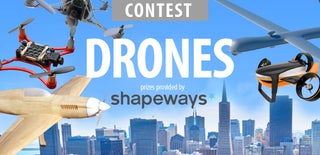Introduction: Raquette Drone or Racket Racer
I was looking for a Strong, Reliable and Easy to build FPV - DRONE - RACER
When I realised that every thing I needed was in my basement.
I had a Badminton Racket made of Carbon and Graphite and all the component to build a quadcopter.
I just cut the handle and installed the necessary material for this machine to make it work; it took me less than 4 hours.
First :
The stuff you'll need :
- A Badminton Racket
- A Board controller (in my case Naze32)
- 4 motors and 4 ESC (Power controller)
- 4 Propellers (And don't buy just 4)
- 1 Battery (3s from 1200 to 1800hm will be good)
- 1 distribution board to connect all the + and - together from battery to ESC (option)
- 1 Remote control
- Wood rings that i will call Washers to fix the motors and some other parts
- I used 20 and 25mm long M3 screws.
- Plastic Straps for the wires and ESC
For FPV you will need a mini camera and a video transmitter and a video receiver + monitor
You can also get an all in one FPV camera (like the Eachine EF01 and MC01)
(I didn't put any link as I'm sure some of you will found better deals or local dealers - You can got to Banggood -GearBest - Hobbyking - Aliexpress etc some customs charge can be apply a local dealer can be a good advisor and some time it's a good place to meet other guys*, some time they have very good deals and you won't have to wait 2 or 3 weeks).
*: Because flying alone is nice but flying with other it's even better ;-)
Step 1: Choosing Your Material
Choosing the right motors and propellers
In this case i recommande motors for 250 or 180 quadcopter.
Mine are MT 2204 - 2300Kv (I'm not going to explain everything but : the first number is the size of the motor the second is the revolution per volts) (The 2212 - 920kv are using bigger props and are used for bigger quad).
Then you will need to buy some propellers (also depending on the battery 3s or 4S) but to start we will use a 3S battery.
The recommended propellers for this motor are 5inch (you will find 5030 or 5040 etc.., so 50 is the size 5inch and 30 or 40 is the propeller pitch see picture - in some cases 4inch will work).
Now we are ready to start.
Step 2: Cutting the Racket
I just used a metal saw to cut the handle of the racket.
Step 3: Wooden Washers
I have built some washer to fix the motor on the stringing (With 3mm MDF see SVG file).
I finally did put one washer on each side of the stringing for the motors axis not to touch the racket strings.
I did use 3mm MDF you can do that by hand or like me using a laser cutting machine that will make an amazing job. 3D Printing can also be an option. You can also print the SVG on paper and glue it on some MDF that will be easier.
(the laser cutter i used is from a Public FabLab in Carrefour numérique de La Cité des Sciences et de l'industrie - LaVillette - Paris ).
Place the motors correctly for the propellers not to touch anything.
The controller (a Naze 32) will be placed in the center.
Attachments
Step 4: Motors and Control Board
After preparing and soldering the connectors on the Naze32 take 5 minutes to have a global look before tightening everything.
At this step before soldering the Naze 32, connect the board to your computer and start the basic configuration with cleanflight. If everything looks fine then you can start soldering.
(Like this if something wrong happen you will know that the Naze 32 was working before).
I have fixed the Naze 32 on a piece of 3mm MDF and on the other side i screwed the distribution board.
Step 5: Place the ESC and Distribution Board
Place the ESC and distribution board.
I bought the ESC with the motors (this was the cheapest way)
You can also buy separated ESC, in this case you will maybe chose smaller ones.
There are also 4 i n1 esc (this can be an other option).
Step 6: Testing and Configuration
I'm not going to show how to use CleanFlight there are plenty of videos on youtube (Painless 360 is making great videos on how to use and configure the Naze 32 and other boards in CleanFlight).
So it's time to try if everything is working fine, always take the propellers off the quad when you test it.
I have use the cross + configuration instead of X
In CleanFlight you will have a graphic that tell you the orientation of the propellers.
They can be clockwise or counter clockwise, with the top of the propellers facing forward.
After testing i did put some extra led and FPV cam (see pictures)
Step 7: Testing
I decided to test it with some friends from the FabLab.
And a journaliste was there he did a nice article in a web magazine called Helicomicro.com
Here is the link : http://www.helicomicro.com/raquette-racer/

Second Prize in the
Drones Contest 2016












